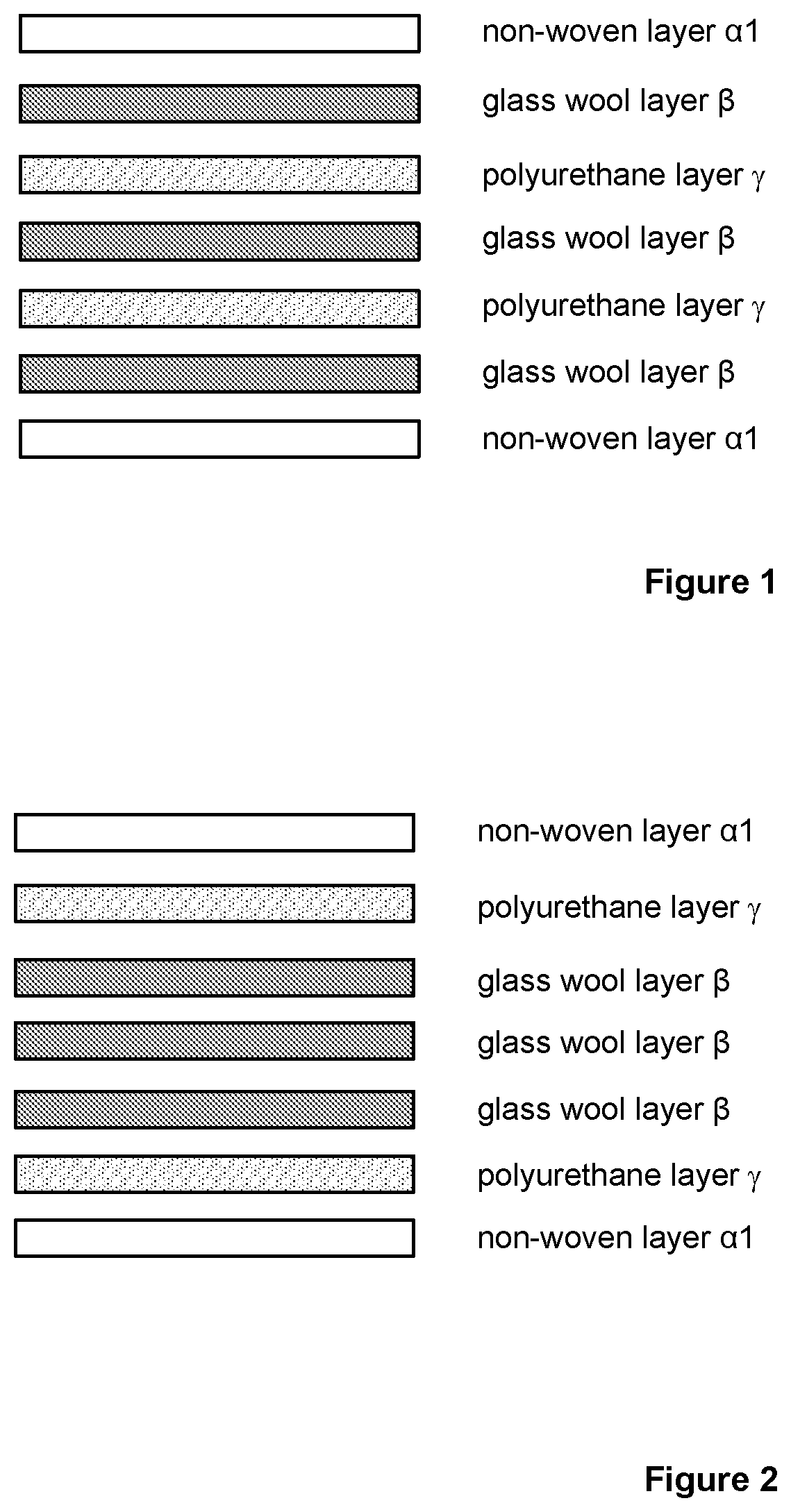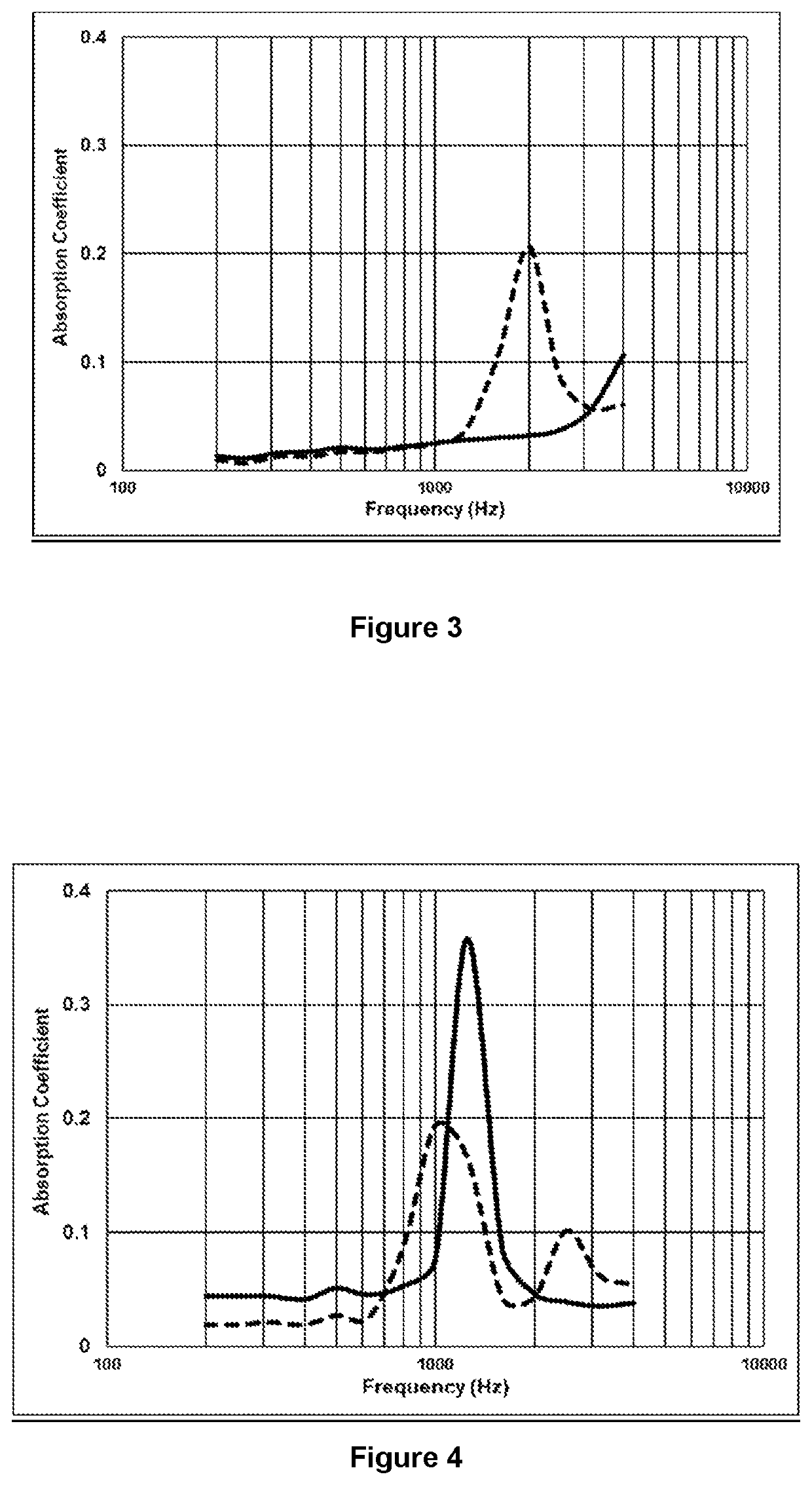A multilayer structure for automotive components
a multi-layer structure and automotive technology, applied in the direction of instruments, synthetic resin layered products, transportation and packaging, etc., can solve the problems of constant automotive industry problems, reduced sound absorption, and fragile sandy surfaces
- Summary
- Abstract
- Description
- Claims
- Application Information
AI Technical Summary
Benefits of technology
Problems solved by technology
Method used
Image
Examples
example 1
Preparation of a Multilayer Structure 1, as Represented in FIG. 1
[0144]In a steel thermoforming tool mounted on a vertical press the multilayer structure 1 of FIG. 1 was prepared.
[0145]With reference to FIG. 1 the following multilayer structure was prepared:[0146]two outer layers α1, made of non-woven viscose-polyester layers comprising polyester, having a total surface weight in the range from 100 to 120 g / m2 with respect to a multilayer structure sample of 100cm2, a thickness of 0.78 mm and made of a blend 50 / 50 of viscose / black polyester-PET fibers, covered with a phenolic coating.[0147]three intermediate glass wool layers β, made of a glass wool fiber bonded with a thermosetting phenolic resin binder (R225) in an amount of 10% with respect to the total weight of the layer β, with very low formaldehyde emission, and a flame retardant additive.[0148]two intermediate polyurethane layers γ having a density value of 25 g / l.
[0149]Polyurethane automotive scraps were firstly provided. A...
example 2
Preparation of a Multilayer Structure 2 as Represented in FIG. 1
[0151]By following the same procedure as in Example 1 by using the layers indicated below the multilayer structure 2 has been prepared.
[0152]With reference to FIG. 1 the following layers were used:[0153]two carbon non-woven outer layers α1, made of PANO (pre-oxidized polyacrylonitrile C-fibers)-polyester fibers covered with a phenolic coating, having a total surface weight in the range from 100 to 120 g / m2 with respect to a multilayer structure sample of 100 cm2 and a thickness at 1 Kpa of 1 mm.[0154]three intermediate glass wool layers β, made of a glass wool fiber bonded with a thermosetting phenolic resin binder (R225) in an amount of 10% with respect to the total weight of the layer β, with very low formaldehyde emission, and comprising a flame retardant additive.[0155]two intermediate polyurethane layers γ having a density value of 25 g / l.
[0156]The polyurethane layer γ had a compression set in the range from 1000 t...
example 3
Preparation of a Multilayer Structure 3, as Represented in FIG. 1
[0157]By following the same procedure as in Example 1 by using the layers indicated below the multilayer structure 3 has been prepared.
[0158]With reference to FIG. 1 the following layers were used:[0159]two outer layers α1, made of needle punched non-woven layers comprising viscose-polyester, having a total surface weight in the range from 100 to 120 g / m2 with respect to a multilayer structure sample of 100 cm2, a thickness of 0.78 mm and made of a blend 50 / 50 of viscose / black polyester-PET fibers, covered with a phenolic coating.[0160]three intermediate glass wool layers β, made of a glass wool fiber bonded with a thermosetting phenolic resin binder (R225) in an amount of 10% with respect to the total weight of the layer β, with very low formaldehyde emission, and comprising a flame retardant additive.[0161]two intermediate polyurethane layers γ having a density value of 22 g / l.
[0162]The polyurethane layer γ had a com...
PUM
| Property | Measurement | Unit |
|---|---|---|
| Temperature | aaaaa | aaaaa |
| Linear density | aaaaa | aaaaa |
| Pressure | aaaaa | aaaaa |
Abstract
Description
Claims
Application Information
 Login to View More
Login to View More - R&D
- Intellectual Property
- Life Sciences
- Materials
- Tech Scout
- Unparalleled Data Quality
- Higher Quality Content
- 60% Fewer Hallucinations
Browse by: Latest US Patents, China's latest patents, Technical Efficacy Thesaurus, Application Domain, Technology Topic, Popular Technical Reports.
© 2025 PatSnap. All rights reserved.Legal|Privacy policy|Modern Slavery Act Transparency Statement|Sitemap|About US| Contact US: help@patsnap.com



